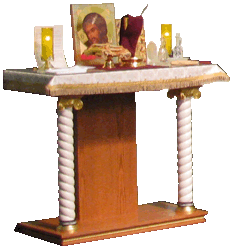
Sign of the Cross
The Sign of the Cross is made with the right hand, with the thumb, index finger, and middle finger placed together, proclaiming our belief in the Blessed Trinity. The remaining two fingers are put in the palm of the hand, indicating the two distinct nature of Jesus, Human and Divine.
In the tradition of the Byzantine Rite, the forehead is touched first, followed by the chest, then the right shoulder followed by the left, confirming that we love the Lord with all of our Mind, Heart, and Strength.
The Sign of the Cross has been a part of Christian faith since the earliest days, but the gesture wasn’t formalized until around 400 A.D. Before the end of the 13th century, both Eastern and Western Christians ‘crossed’ themselves from right to left. Pope Innocent III (1198-1216 A.D.) said: “This is how it is done: from above to below, and from the right to the left, because Christ descended from the heavens to the earth”. But, Innocent also noted that “Others, however, make the sign of the cross from the left to the right, because from misery (left) we must cross over to glory (right), just as Christ crossed over from death to life, and from Hades to Paradise.” In the following centuries Latin Rite Catholics evolved this practice to cross from left to right.
Fasting and Abstinence
Abstinence
• The law of simple abstinence forbids the use of meat, permitting the use of eggs and dairy products.
• All the faithful of the Archeparchy who receive the Eucharist are bound to abstain. Abstinence is obligatory on all Wednesdays and Fridays of the Great Fast.
Strict Abstinence
• The law of strict abstinence (fast) forbids the use of meat, eggs and dairy products. While they are permitted, facsimiles, substitutes, and synthetic derivatives violate the intention and spirit of the law of strict abstinence.
• All the faithful of the Archeparchy who receive the Eucharist are bound to observe strict abstinence.
• Strict abstinence (fast) is to be observed on Pure Monday, February 20, (the first day of the Great Fast) and on Great and Holy Friday, April 7, 2023.
Dispensations
• Priests and parents are to see to it that minors are educated in the authentic sense of penance.
• Pastors and administrators, because of a just cause and taking into account acceptable reasons due to personal circumstances, may grant to the individual faithful as well as to individual families, dispensations, transferals, or commutations of abstinence and strict fast into other pious practices. Superiors of religious houses or clerical institutions enjoy these same faculties relative to their subjects.
Liturgical Services
• The Divine Liturgy of the Presanctified Gifts takes precedence over all other Lenten Devotions.
• The Divine Liturgy of the Presanctified Gifts only is to be celebrated on Wednesdays and/or Friday evenings of the Great Fast and also on Monday, Tuesday, and Wednesday of Holy Week.
• Other services are encouraged during the season of the Great Fast, but only those in keeping with the traditions of the Byzantine Church, namely, Lenten Vespers, Lenten Hours, Akathist to the Passion, and Lenten Devotions.
• On Wednesday of Holy Week, the Office of the Holy Anointing may be incorporated into the Presanctified Divine Liturgy.